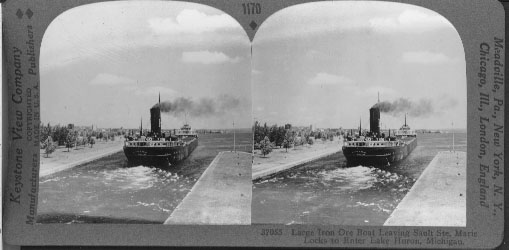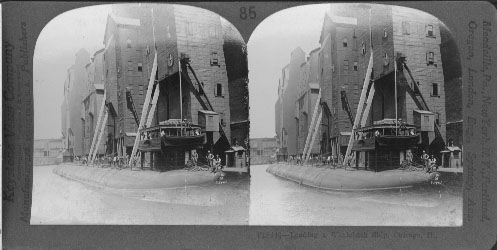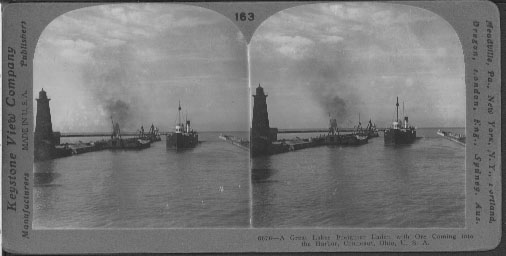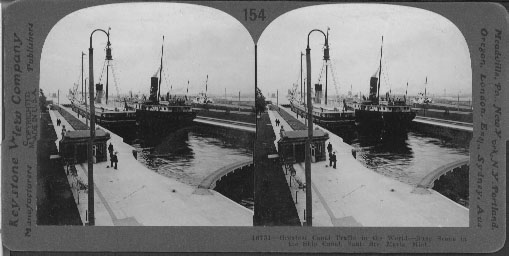You are here:
- CMP Home >
- Web Exhibits >
- Stereoscopic Images >
- Shipping
- SUBJECT:
- COMPANY:
- GEOGRAPHIC LOCATION
Stereoscopic Images of Cleveland in 3-D
Shipping
- This gallery contains 4 slides. Click on the arrows to advance to the next or previous slide.
- Click on the the photo to see the 3-D rendering.
- To view the total effect of the 3-D versions of the images use anaglyph 3-D Glasses (red/cyan).
-

Large Iron Ore Boat Leaving Sault Ste. Marie Locks to Enter Lake Huron, Michigan
THE LOCKS AT SAULT STE. MARIE, MICHIGAN: We hear a great deal of the Suez Canal and of the Panama Canal, but there is a canal in the United States that handles more traffic than either. The Great Lakes in the United States furnish the most remarkable inland waterway in the world. To make this waterway navigable all the way from Duluth, Minnesota, to Buffalo, New York, it was necessary to do several things. The river connecting Lakes Erie and Huron had to be deepened and the connection between Lake Huron and Superior had to be negotiated in some manner.
In order to get boats through from Lake Superior to Lake Huron a canal had to be built around the rapids of St. Mary's Falls Ship Canal, popularly called the "Soo Canal." More tonnage passes through it yearly than through any canal in the world. This canal is 1 1/2 miles long and deep enough to carry the largest lake boats. One of the locks alone is 1,350 feet long and will carry boats that draw 24 1/2 feet of water.
Boats laden with iron ore from Superior, grain from Duluth, or coal from the Pittsburgh district all pass through this waterway. The odd looking freighter entering Lake Huron is well adapted to carrying ore or coal on the lakes. It is like a huge iron box with a flat bottom. There is a little house at each end. In one the crew lives. In the other is machinery. Some of these boats carry 10,000 tons of freight at one time. In 1939 more than 69,850,000 tons of freight went through the canal. The value of this tonnage was estimated to be about $1,012,829,000. -

Loading a Whaleback Ship, Chicago, Ill.
Chicago is situated in the center of the Great Central Plains, one of the most fertile and prosperous regions of the world. It is a wonderful grain producing district and has been called the "Bread Basket of the World." Most of the grain raised here and in the agricultural districts of the West is shipped to Chicago for distribution.
In this picture a cargo of grain is being loaded into a whaleback ship at one of the great grain elevators, with a comined capacity of thirty-two million bushels. Inside the tall building which we see in this view are enormous grain bins twelve feet square and eighty feet deep. The grain is drawn up into these bins by means of a series of buckets fastened to an endless belt which extends from the top of the bin to the loaded car or vessel. From these bins the grain passes through a hopper, which measures accurately, and is then sent in a continuous stream through great spouts into the back of the "Whaleback," to be transported to some port in the Great Lakes. The "Whaleback" is an extraordinary form of vessel designed especially for Lake freighters. These low, flat vessels use steam only, are without masts, and their peculiar shape, resembling the back of a whale, makes them safe in heavy storms which come up more suddenly in the Great Lakes than on the ocean. A heavy sea can wash over them without doing any damage.
The value of the grain in one of these elevators varies with the outlook for a good or poor crop - in the near future. Speculators also raise and lower the price, as is done with oil. -

A Great Lakes Freighter Coming Into Harbor, Conneaut, Ohio, U.S.A.
The smaller ore boats carry about 3,000 tons of ore while the largest carry more than 12,000 tons. Ths one shown in this view is a medium-sized boat and may be carrying 5,000 tons. The view is to the north across Lake Erie. On the west side of the harbor are two lighthouses. These are range lights. They are placed on the west side of all Lake Erie harbors. At night, the boat must get in line or in range with these two lights while yet several miles from shore. Then by keeping in range with then it is sure to make the harbor.
The report of the collector of the U.S. Customs shows that 1362 vessels entered Conneaut Harbor during 1940. The receipts were 4,038,755 tons of iron ore; 52,104 tons of pier stone; and 458 tons of other freight. This was more iron ore than received at any other port on the Great Lakes. The iron ore receipts for 1950 will probably be 5,250,000 tons, but Ashtabula, Ohio will receive somewhat more than Conneaut this season. The shipments from Conneaut Harbor for 1940 amounted to but 413,320 tons, 98 per cent of which was coal, and one-third of this coal was used as fuel on the boats.
The receipts and shipments mentioned concerned domestic commerce only. The imports for 1940 were valued at $53,216. They were mainly lumber. The exports were valued at $3,774,562, of which about 15 percent was bituminous coal and nearly 85 percent steel rails and other forms of manufactured steel. The foreign commerce was wholly with Canada. -

Large Iron Ore Boat Coming into Sabin Locks, Sault Ste. Marie, Mich.
The Great Lakes furnish the most remarkable inland waterway in the world. To make this waterway navigable all the way from Duluth, Minnesota, to Buffalo, New York, our country had done several things. The lake and rivers connecting Lakes Erie and Huron have been deepened. A canal has been built around the rapids in the St. Mary's River, which is between Lake Huron and Superior. This is known as the "Soo Canal." Lake Superior is twenty-three feet higher than Lake Huron, so the canal is provided with locks which lift the boats going west and lower those traveling east. This "Soo" canal handles more freight than any other canal in the world.
The odd looking "freighter" entering the locks is very well adapted to carrying ore or coal on the lakes. It is like a huge iron box with a flat bottom. There is a little house at each end. In one the crew lives. In the other is machinery. Some of these boats carry 10,000 tons of freight at one time.
What do they all carry? Many carry iron ore, which comes from the mines near Hibbing, to eastern ports. At Duluth and Superior the world's greatest elevators (store houses) are full of wheat awaiting shipment. Copper and lumber also make up many cargoes. The westward bound boats carry a greater variety of freight. Coal fills the most boats. (Why?) Others are loaded with dry goods, clothing, groceries, automoblies, machinery, and many smaller manufactured articles.



